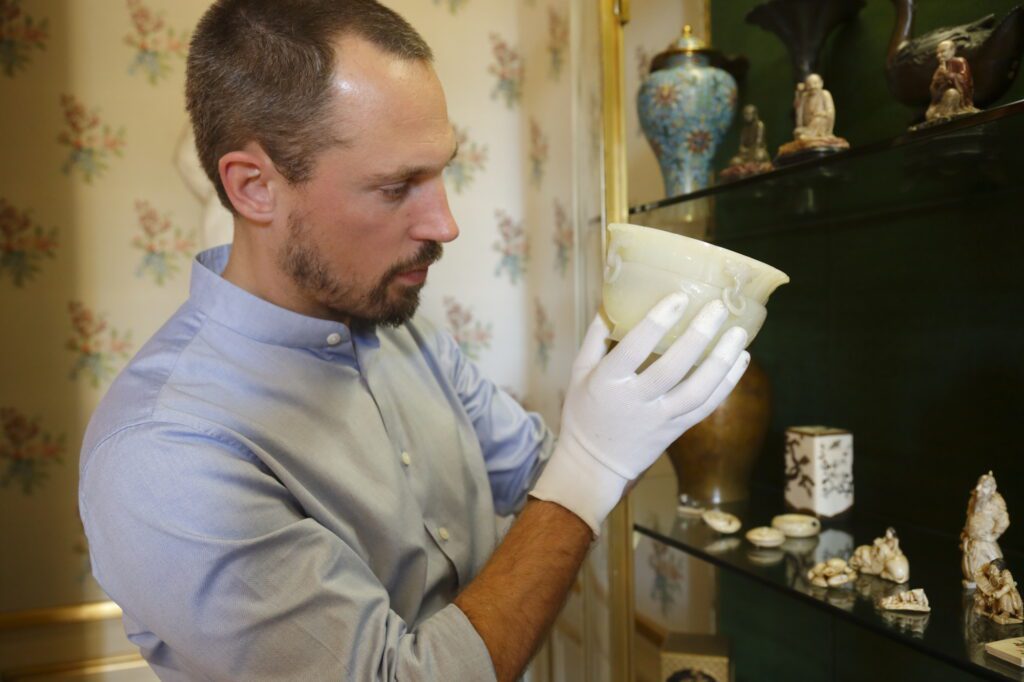Our interview series continues, this time with Jean-Baptiste Clais. Clais is an ethnologist and an art historian. He’s the curator of the Asian collection (China, Japan, and some India) and European porcelains at the Department of Art Objects at the Louvre. In his free time, he researches Mughal arts, especially hardstones and luxury weapons. As an ethnologist, he specializes in contemporary popular culture (Star Wars, Internet, video games, comics, blockbusters). He volunteers in a non-profit specialized in these fields, MO5.com, to prepare a collection and project for a future museum of popular culture.
At first glance, the two main tenets of Jean-Baptiste Clais’ work seem totally unrelated. On the one side, he is a curator at perhaps the world’s most famous museum in which some of most ancient objects are displayed; on the other, he studies and teaches the ethnology of contemporary popular culture like Star Wars and the evolution of video games.
For Clais, however, the two are not so very different at all. It all started during his studies: while on a curatorial track in art history, he was deeply interested in the geek culture and started studying early video game collectors. In their quest to preserve the early computer models, he recognized the development of heritage. Clais was later involved in putting together an exhibition about video games and their connection with culture, cinema, and art, at the Grand Palais, one of the largest exhibition spaces in the world.
Clais breaks down this connection by explaining that heritage is something that comes hand in hand with technology and modernity. In his studies, he has noticed a recognizable pattern. In every society around the world the expanding role of technology comes with three phenomena: the development of science fiction, the ‘re-enchantment’ through fantasy, and the development of heritage preservation and museums. Particularly, he notes that the fantasy genre of any country draws from its cultural heritage.
What about virtuality?
When it comes to distinguishing the difference between the digital and the physical realities, Clais takes a pragmatic and simple approach. All realities are physical – for example, he points out that when you are having a meeting on Zoom, you have to sit in a chair, face a screen, and wear a headset, whereas before this so-called “digital world” opened, you were not doing that. He states that “There is nothing immaterial in digital – just think about the pollution due to the servers, for example.”
During the COVID-19 lockdown, many people turned to digital tours of museums such as the Louvre. Clais notes that this technology has been present for many years already but was only ‘discovered’ this year as people needed entertainment in quarantine. However, he does not see it as a solution for museums, and nor is it the future. When it comes to technological integration, he believes that museums should not try to be at the early end of innovation, and instead should focus on partnering with people and companies who already know how to use the technology. His view is that what works in the long term in the digital sphere is not advertisement and buzz, but content.
When it comes to digital art, Clais takes the position that “If you exaggerate a lot, you have two types of digital art: digital art that is made by people who are in the digital culture and can exploit all the possibilities of the technology, and classical artists who just take on the digital to create buzz.” For example, if someone trained in sculpture starts to use a computer in his work, he “can do nice work and if he’s very gifted, beautiful work.” But it is the person who started with the computer who will be able to comprehend all the possibilities and will exploit the technology at its maximum, which is where the most interesting and innovative work lies.
Post Reality = Post Truth?
Finally, Clais ends with a word of caution around the concept of post reality, which he connects with the growing trend, especially in developed countries, of the denial of rationality and the denial of fact. In his opinion, humanism is a more important topic.
“The problem of post reality for me is not related to digital…but in the sense where the core values of society are shaken. We need to refocus on humanism and not on antagonizing people. If you ask me what post reality is for me today, it’s people explaining we have enemies. We don’t have enemies.”
